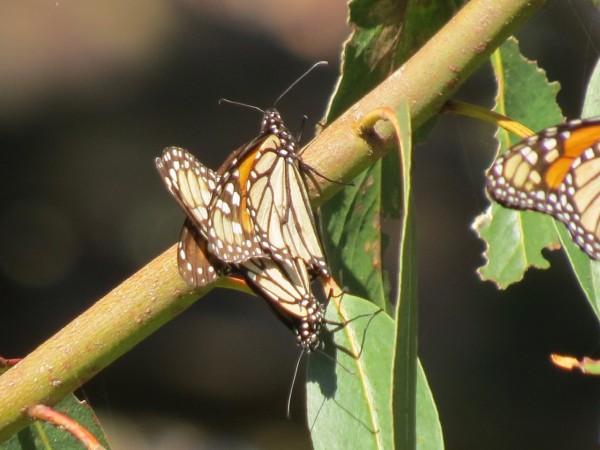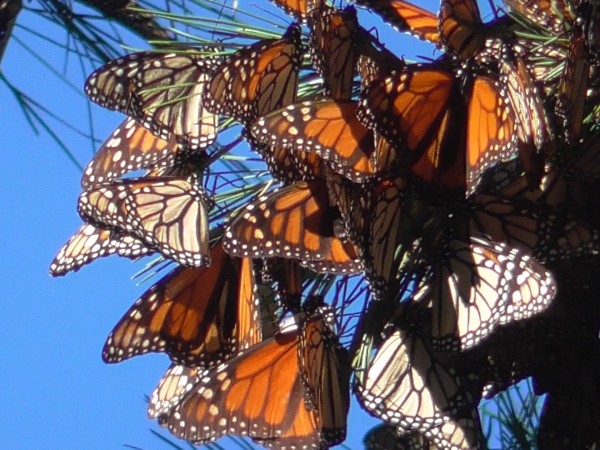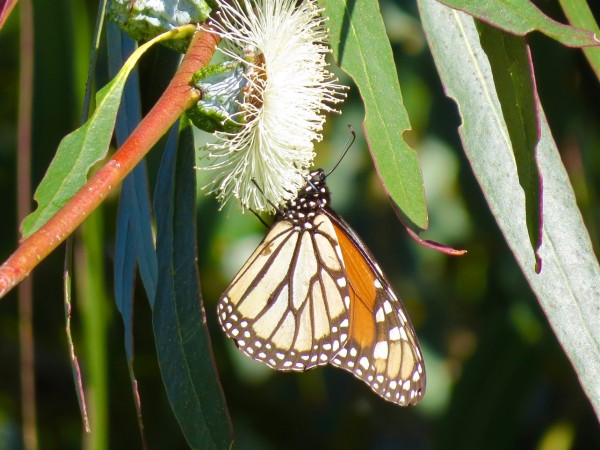Letter from Gail Morris: Western Monarch Winter 2021–2022 Report #3
Published: 01/19/2022
Dear Western Monarch Friends,
Western monarch reported sightings were few this week. Warming temperatures brought a change in monarch activity at the overwintering sites to share as 2022 continues to unfold.
Western Monarch Sightings
We have only one new sighting! We know monarchs are still active in the coastal and desert regions of California and Arizona. Remember to keep your cameras with you when you are hiking or taking a neighborhood walk and be sure to snap a photo when you can.
On January 10 Patty in Tempe, Arizona, reports: “Earlier this afternoon, I saw a wild monarch flying around my back yard in Tempe, AZ. I did not see a tag. It is a nice sunny day with 71 degrees and a breeze of 14 mph from the NE. Two hours later, I saw a tagged male monarch nectaring on my Desert Milkweed. I was not able to read the tag number but it could have been one I tagged last week.”
California Overwintering Monarchs
Diana Magor reports the following monarch counts at Lighthouse Field (LF) in Santa Cruz, California:
“1-2-22: 504 counted. Official count day."
“1-9-22: estimated 270 total, many flying, several matings. Warm, sunny, high 60s."
“1-13-22: 213 total, all under Cypress boughs. Overcast, cool, less than 55F."
“Appears that they [monarchs] are starting to leave the LF colony. On 1-9-22, in the hour I was there, at least 3 matings and at least 1 attempted mating. Warm, sunny afternoon. Many flying so 270 was an estimate, prob within 15%. Many feeding on Eucalyptus flowers.” Be sure to see Diana’s photos.
We reached out to Pacific Grove Museum’s Stephanie Turcotte’s about the monarch count at Pacific Grove (PG) this week and she shared this fascinating discovery visiting the area on Thursday.
“Well, actually…I do have some really interesting observations to share. I just came back from an informal walk through the PG grove since our temps have been so warm. I wanted to see how the narrative has changed since we last counted on 1/7/2022. And indeed it has."
“The clusters have moved again. While during Nov. and Dec. they were concentrated mostly in the interior, on the Monterey Pines and a few Cypress, their clusters are beginning to spread out again to Monterey Pines and Cypress AND Eucalyptus where they were at the beginning of the season, in October, along the visitor path. They appear to be all inside the grove, but not right in the middle and low down. The ‘Charlie Brown’ tree (Monterey Pine) which had about 5,000 monarchs clustered all over it at last count, has only a few clusters from what I can see without officially going into count."
“They are up quite high in the pines. In the 3 or so Eucalyptus their clusters are small, only about 10-20 monarchs on various trees and not as high up, maybe 15-20ft."
“I am still finding monarchs predated upon. There were two small males today. One was dead with no abdomen and the other one was still alive with no abdomen."G
“Yesterday I had the first monarchs visit my yard to gather nectar from my Bottle Brush. Both were female. Their wings were pretty tattered, a hole or two in places. Their color was pretty dull, many of the scales gone. I haven’t seen any monarchs in my yard since they began arriving late September through October. November and January there was no sign of the monarch’s movement. As I said, yesterday indicated that some are venturing away from the grove.”
A special thank you to both Diana Magor and Stephanie Turcotte for their reports. Next week we’ll visit a surprise discovery of a small aggregation of overwintering monarchs in Arizona as well as California site updates.
Winter Monarch Sightings Are Important!
Where are monarchs this winter? If you are seeing monarchs, be sure to report to Journey North whether they are adults or eggs or larvae. Provide as much information as you can such as weather conditions (it’s okay to estimate). Your detailed description of what you see can include, but is not limited to, the monarch’s gender and activity and, if known, the type of flowers if they are nectaring. If you can, observe the condition of the wings – are they fresh and new or worn and tattered or something in between – helps us learn more about monarch age and survival. We realize it isn’t always possible, but please take a photo if you can. Thanks so much for your help.
Gail Morris is the Coordinator of the Southwest Monarch Study (www.swmonarchs.org), a Monarch Watch Conservation Specialist, and the Vice President of the Monarch Butterfly Fund and the Central Arizona Butterfly Association. The Western Monarch Population News is based on comments provided to Gail Morris. We hope to increase the number of sightings and therefore photos and comments entered into the Journey North. We rely on the volunteers who communicate regularly with Gail and who agree to participate in our effort to increase awareness of the population of western Monarchs. You can reach her at gail@swmonarch






